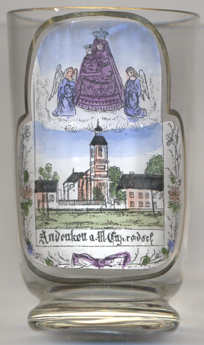

|
| ÖSTERREICH | AUSTRIA |
| Bundesland: Niederösterreich | Lower Austria |
| Bezirk: Mödling |
Maria Enzersdorf is situated at an elevation of 225 m to the south of Vienna. It was first mentioned in a document in 1130 as Engelschalkesdorf.
In the late 14th century the name changed to Enzersdorf. After 1730, it became known as Maria Enzersdorf.
A former place of pilgrimage and vine-growing, the market town has begun to concentrate its economic activities on the service sector in the 20th century.
From 1938 until 1954 Maria Enzersdorf was part of Vienna (Groß-Wien, Greater Vienna). It became a market town in 1955.
Between 1960 and 1976 the modern part of the town, the "Südstadt" (south town), was added to the old centre.
On 16 December 1999 the official name of the municipality was changed from Maria Enzersdorf am Gebirge to Maria Enzersdorf
(the old identifier am Gebirge refered to the town's location among vineyards).


The  Franciscan parish and former pilgrimage church [centre] was built in 1632.
The miracle-working image of Our Lady ("Maria, Heil der Kranken", "Our Lady, Salvation of the Diseased") was brought to the parish church in 1730.
The outstanding Baroque façade dates from 1787.
A new transcept and chancel were added in 1906.
Franciscan parish and former pilgrimage church [centre] was built in 1632.
The miracle-working image of Our Lady ("Maria, Heil der Kranken", "Our Lady, Salvation of the Diseased") was brought to the parish church in 1730.
The outstanding Baroque façade dates from 1787.
A new transcept and chancel were added in 1906.
The  Franciscan monastery was founded in 1454 by Johannes von Capistran (1386–1496; canonized as a Saint by the Catholic church in 1690).
The buildings of the present monastery were built after 1725 after the destruction by the Turks of the older monastery buildings.
Franciscan monastery was founded in 1454 by Johannes von Capistran (1386–1496; canonized as a Saint by the Catholic church in 1690).
The buildings of the present monastery were built after 1725 after the destruction by the Turks of the older monastery buildings.



Glass no. 2289 [left] is a souvenir from Mödling.
The top right part of the picture on the glass shows
 Liechtenstein
Liechtenstein
For the description of the other sights depicted on glass no. 2289 see Mödling.
![[scale]](lineal.jpg)